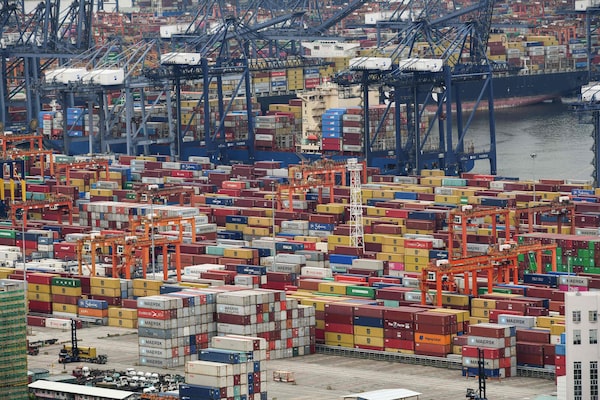
Cargo containers are stacked at Yantian port in Shenzhen in China's southern Guangdong province. China's exports spiked more than expected in June as countries around the world pushed towards a pandemic recovery, official data showed on July 13, 2021, while imports spiked on the back of rising commodity costs.STR/AFP/Getty Images
Commodity prices have been struggling in recent weeks, pausing this year’s remarkable run on materials stocks and raising the question of whether the opportunity for investors has ended.
But some observers remain convinced that a commodities “supercycle” – an extended period of strong demand for raw materials – is continuing, offering a buying opportunity for anyone who missed the first stage of the rally.
“Although most of the world continues to battle the COVID-19 pandemic, rapidly increasing vaccination rates combined with revved-up economic stimulus has significantly improved the outlook (and sentiment) for commodities,” Orest Wowkodaw, an analyst at Bank of Nova Scotia, said in a report this week.
The bullish take on commodities follows sharp gains this year, as the global economy recovers from last year’s lockdowns amid robust government spending and low interest rates.
The Bloomberg Commodities Index is up 20 per cent since the start of the year. Copper, one of the stars of the rally because of its importance to the technology that underpins renewable energy and electric vehicles, touched record highs in May.
For the past two months, though, the commodities index has zigzagged, and the price of copper has retreated by 12 per cent.
Freeport-McMoRan Inc. , a global copper producer whose share price soared as much as 72 per cent from the start of the year to its high in May, is also struggling – its share price has slipped 22 per cent from its peak.
Add tumbling prices for lumber and corn, and commodities start to look like a dying trade for investors.
The setbacks come as economists expect the global economy’s rebound will level off soon, particularly in China. The era of ultralow interest rates may be winding down as well, as inflation revs up.
Bond yields, which rose at the start of the year in anticipation of strong economic growth, are well off their highs, possibly reflecting a more subdued economic outlook.
Although the yield on the 10-year U.S. Treasury bond jumped above 1.4 per cent on Tuesday after the U.S. rate of inflation soared to a 13-year high of 5.4 per cent in June, the yield is down from a recent high of 1.7 per cent in May.
So why consider a bet on commodities now?
Part of the case here rests on the belief that Chinese-led commodity consumption last year has become more broad-based as more economies recover from the pandemic. As well, companies are set to report impressive quarterly results driven by higher commodity prices.
Alexander Hacking, a Citigroup analyst, says he believes copper producers are set to report their strongest second-quarter financial results in many years, underpinning his bullish view. The price of copper, he pointed out, was US$4.40 a pound in the second quarter, up 81 per cent from the same period last year.
Mr. Wowkodaw expects fears related to rising interest rates and slower economic activity in China are transitory. Demand for commodities – again, copper is the highlight given its strong ties to economic activity – will remain strong over the longer term as countries work toward cutting their carbon emissions with large investments in renewable energy, offsetting rising output as miners capitalize on strong prices.
He expects the copper market to be roughly balanced in 2022-23, before demand outpaces supply in 2024-25, leading to what he calls “enormous deficits.” He’s also enthusiastic about uranium, given the rising interest in nuclear energy, and iron ore, given the strong demand for steel.
“Valuations are now significantly more attractive and pricing in a healthy discount to spot commodity prices,” Mr. Wowkodaw said. “Given the impressive free cash flow generation for most miners, we anticipate improved shareholder returns to begin shortly.”
Be smart with your money. Get the latest investing insights delivered right to your inbox three times a week, with the Globe Investor newsletter. Sign up today.